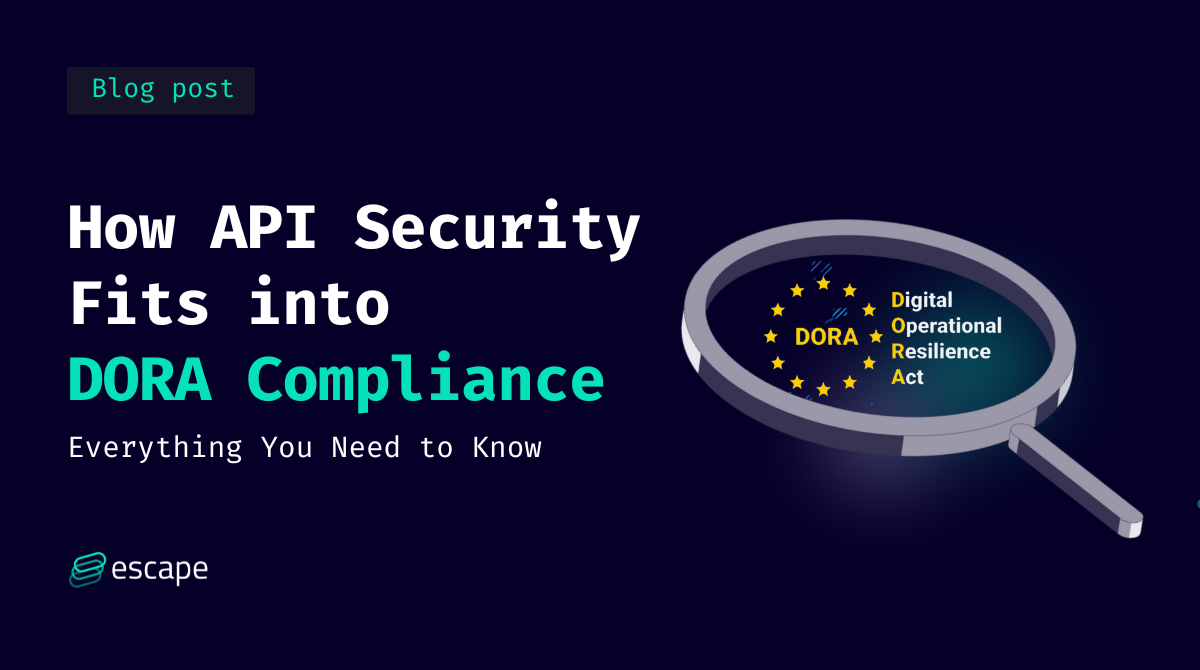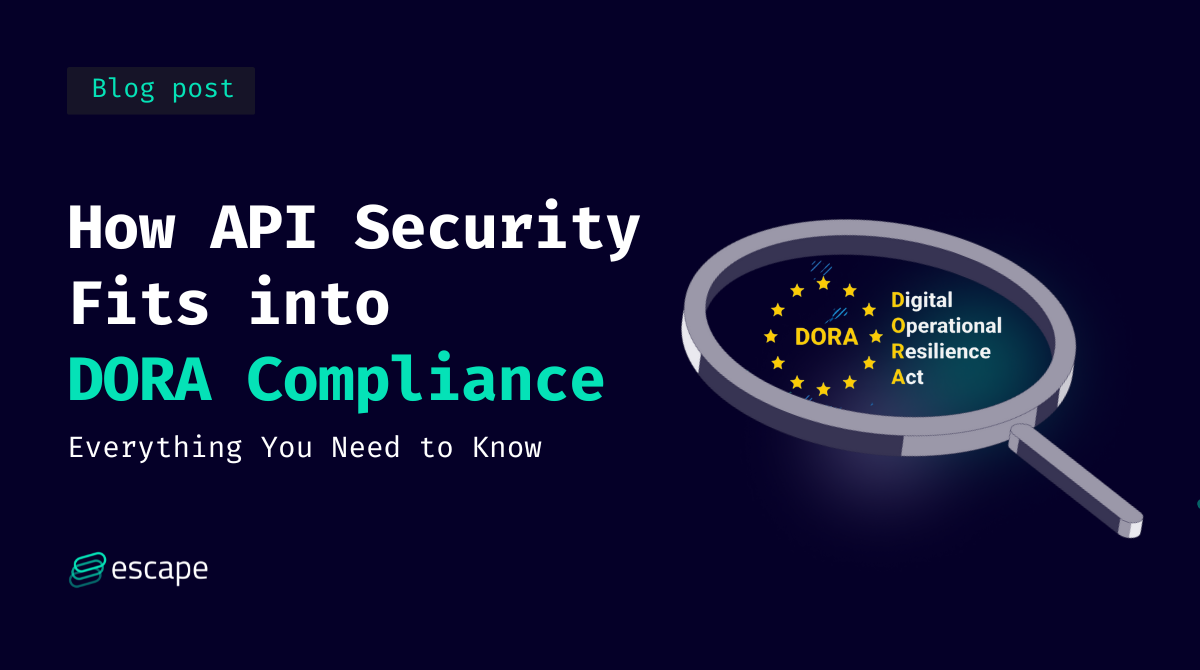
2024-9-21 00:33:57 Author: securityboulevard.com(查看原文) 阅读量:4 收藏

With over 22,000 financial institutions and IT service providers now affected, the Digital Operational Resilience Act (DORA) represents an important shift in cybersecurity for the EU’s financial sector.
DORA forces tighter collaboration between regulators, financial institutions, and third-party vendors. It’s not just about protecting internal systems anymore but ensuring the resilience of external digital connections, like APIs, which are the backbone of modern data flows.
APIs have become the key for data transmission and communication between systems, making API security a cornerstone of DORA compliance. And for good reason: In 2023 alone, nearly 70% of financial services and insurance companies experienced rollout delays due to API security issues. Worse yet, 92% encountered security problems in their production APIs, and one in five suffered a full-blown API security breach.
This alarming rise in API attacks underscores the need for robust compliance standards to secure these vital connections—whether through PCI-DSS 4.0, which introduced over 50 new requirements, or DORA, which sets stringent guidelines for financial institutions.
💡
A comprehensive regulatory framework, DORA aims to protect the financial services sector and its customers against Information and Communication Technology (ICT)-related incidents by enhancing how organisations mitigate, document and react to potential threats and vulnerabilities.
Compliance with regulations is never easy, but it is a must.
Should it always feel like a burden? Of course, not.
In this article, we’ll explore how Escape's API security platform can help you meet the requirements outlined by DORA with ease, focusing on four key areas: data transmission security, third-party risk, governance, and the need for automation and testing before release in production.
How API Security Fits Into DORA requirements
Data transmission security
One of the key components of DORA is securing data transmissions between financial institutions and their third-party service providers. DORA’s Article 9 sets clear requirements for the secure exchange of data between financial institutions and third parties, stating that organizations must ensure the "confidentiality, integrity, and availability of data, including during transmission and storage." APIs, as conduits for data transfer between systems, play a central role in this.
In order to achieve the objectivs referred to in paragraph 2, financial entities shall use ICT solutions and processes that are appropriate in accordance with Article 4. Those ICT solutions and processes shall:
1. ensure the security of the means of transfer of data;
2. minimise the risk of corruption or loss of data, unauthorised access and technical flaws that may hinder business activity;
3. prevent the lack of availability, the impairment of the authenticity and integrity, the breaches of confidentiality and the loss of data;
4. ensure that data is protected from risks arising from data management, including poor administration, processing-related risks and human error.
APIs often expose sensitive data like personally identifiable information (PII) and financial transaction details. Escape helps organizations secure their APIs by detecting exposed sensitive data and by detecting vulnerabilities in API endpoints before they can be exploited. Escape’sAPI exploration automatically maps out all the APIs in your environment, uncovering shadow APIs that may be transmitting data without the proper security measures in place.
For financial institutions, this translates to greater visibility and control over data flows, ensuring that no API goes unnoticed or unsecured. As DORA compliance requires continuous monitoring of data transmissions, an API security platform like Escape becomes essential.
Third-party risk
Financial institutions rely heavily on third-party service providers, and APIs are the gateway through which many of these vendors access core banking systems. This introduces significant risk, as third-party APIs may become the weakest link in the supply chain. DORA places substantial emphasis on managing these risks, as outlined in Article 28, stating that financial entities must ensure that third-party providers “implement and maintain appropriate measures to manage ICT risks" and that institutions must "ensure the quality and integration of ICT services provided by third parties."
You need to start simple and to be able to answer two questions: Who are your vendors? What third-party apps do you have connected?
One of the biggest challenges here is the concept of shadow APIs—those untracked, unauthorized, or forgotten endpoints that can remain active long after their intended purpose. Shadow APIs expose financial institutions to vulnerabilities, making it difficult to track and control third-party access. DORA’s Article 28 further reinforces the need for financial institutions to "assess third-party ICT service providers’ ability to protect the integrity, security, and confidentiality of data, and to manage risks related to outsourcing."
Escape’s API discovery capabilities allow financial institutions to detect and manage internal and third-party APIs. Make sure your selected tool can discover APIs both inside and outside of an API gateway, WAF, or proxy.
Financial institutions should adopt a proactive approach to third-party risk by securing API interactions and continuously testing the integrity of third-party connections.
Governance
Achieving operational resilience is not just about technology—governance must be at the core of every compliance initiative, and it's a must in DORA.
Financial entities shall have in place an internal governance and control framework that ensures an effective and prudent management of ICT risk, in accordance with Article 6(4), in order to achieve a high level of digital operational resilience. – Article 5 of DORA
DORA’s governance requirements bring the conversation back to the boardroom. Financial institutions need top-down buy-in to successfully implement the necessary security measures across their API infrastructure. A strong governance model will control not just how internal and external APIs are deployed but also how they adhere to regulatory requirements like DORA.
“I like to think of governance as controlling the controlling. So, it’s high-level thinking about what are we dealing with regarding regulation, ethics, business strategy, and aligning all those things into a policy.” – Rob van der Veer, Creator of OWASP AI Exchange
Without C-level buy-in, it becomes challenging to implement the necessary security policies across an organization. DORA compliance will demand a culture of security governance that aligns business strategy with cybersecurity policies.
Escape’s platform can assist in making these conversations easier. By providing clear, well-structured inventory of all APIs and actionable reports on API vulnerabilities and risks, it allows C-level executives to make informed decisions on where to allocate resources and how to align security policies with business strategies.
This kind of visibility is crucial for ensuring that governance becomes more than just a compliance checkbox—it becomes a core part of the organization’s operational resilience strategy.
Automated testing
DORA places a strong emphasis on automated testing and ongoing security assessments to ensure resilience. Article 25 specifically mandates that financial institutions establish a "digital operational resilience testing program" which must include a wide range of tests such as vulnerability assessments, network security assessments, source code reviews, penetration testing, and more.

The regulation further states that financial institutions should "prioritise, classify, and remedy all issues revealed throughout the performance of the tests" and that they must establish internal validation methodologies to ensure that all identified weaknesses or gaps are properly addressed.
Escape’s platform directly supports these requirements with automated vulnerability scanning, API security testing, and risk analysis. It allows institutions to continuously monitor and test their API environments, ensuring that all vulnerabilities are detected and mitigated before they become a risk in production. Escape’s testing also ensures compliance with DORA by helping institutions identify and remedy weaknesses before deployment.
What is the impact of non-compliance with DORA?
Non-compliance with the Digital Operational Resilience Act (DORA) carries significant consequences for financial institutions and their IT service providers. The regulation is designed to ensure the operational resilience of financial entities in the face of increasing cyber threats, and failing to adhere to its guidelines can have both legal and financial repercussions.
1. Hefty Fines and Penalties
DORA mandates strict supervision from financial regulators across the EU.
The European Supervisory Authorities (ESAs) have the power to impose fines for noncompliance. Firms that violate DORA’s requirements face fines of up to two percent of their total annual worldwide turnover, and an individual faces a maximum fine of 1,000,000 euro.
Third-party providers designated as critical by the ESAs face even higher fines for noncompliance— up to 5,000,000 euro or, for an individual, a maximum fine of 500,000 euro. If a financial entity fails to report a major ICT-related incident or threat, the ESAs can also impose a fine.
These financial penalties are designed to incentivize adherence and send a clear message about the importance of operational resilience in the financial sector.
2. Reputation Damage
In an industry built on trust, a publicized failure to comply with DORA can result in severe reputational damage. Customers and stakeholders expect financial institutions to safeguard their data and maintain seamless service. A failure to comply with DORA could signal vulnerability, leading to loss of business, customer trust, and competitive positioning in the market.
3. Increased Risk of Cybersecurity Breaches
Beyond the financial and reputational consequences, non-compliance with DORA increases the likelihood of cybersecurity incidents. Without the mandated API security, third-party risk management, and governance practices, institutions are more vulnerable to cyberattacks, including API breaches, data leaks, and operational disruptions. These breaches can not only harm customers but also lead to further regulatory scrutiny and operational breakdowns.
4. Operational Disruptions
DORA’s core objective is to ensure that financial institutions can withstand operational challenges, especially those caused by cyber incidents. Non-compliance means an institution is likely unprepared to handle disruptions caused by cyberattacks or technical failures, putting critical financial services at risk. Prolonged disruptions can impact entire supply chains, cause economic instability, and ultimately lead to long-term financial damage for the institution.
Conclusion: Start Now, Build Inventory
The road to DORA compliance is not an overnight journey. It requires financial institutions to take a proactive stance, especially when it comes to securing their API infrastructure.
As highlighted during my recent webinar, "DORA: Understand What is at Stake," it’s essential to start now.
Begin by building an inventory of all your APIs, both internal and external, and continuously monitor them for vulnerabilities. With the right tools, like Escape’s API discovery security platform, financial institutions can meet DORA’s requirements while ensuring their APIs are both secure and resilient.
The regulatory environment is only going to get stricter. By starting now, institutions can position themselves to not only meet the current DORA standards but also adapt quickly to future changes.
💡Want to learn more? Discover the following articles:
- Security challenges in the financial sector⎪Max Imbiel (CISO, Bitpanda)
- Case Study: How Sungage Financial improved their application security within 1 week
- Why API Discovery is Important for Financial Companies
- The EU’s PSD2: API Security and Financial Services
*** This is a Security Bloggers Network syndicated blog from Escape - The API Security Blog authored by Alexandra Charikova. Read the original post at: https://escape.tech/blog/how-api-security-fits-into-dora-compliance/
如有侵权请联系:admin#unsafe.sh
